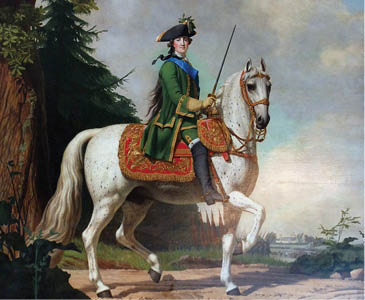Getting Around St. Petersburg

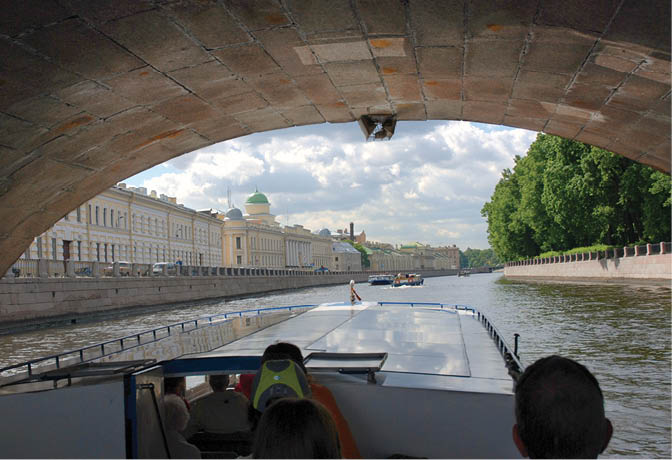
Sightseeing boats provide tours of the city’s canals.
If you are visiting St. Petersburg for the first time, you’re well advised to book an organized tour of the city. It is possible to explore St. Petersburg independently, but you must obtain a visa before the cruise and most taxi drivers don’t speak English. You will make better use of your time in port if you take escorted tours ashore, either through the cruise line or directly with a local operator. Licensed tour guides can take advantage of early admissions to major attractions and use experienced drivers for efficient timing.

St. Petersburg’s Marine (Sea) Facade Cruise Port.
Cruise ships visiting St. Petersburg no longer dock at the cargo quays at the southwest side of the city but at one of two ports dedicated to cruise ships. The main cruise terminal is located on the west side of Vasilyevskiy Island, about 3 miles (5 km) from the city centre at the Marine Facade Cruise Port (opened 2011). Two smaller terminals are located on the Bolshaya Neva (the south arm of the Neva River) at the English Embankment, about half a mile from the city’s central squares and at the Lt. Schmidt Embankment on the opposite river bank. These terminals usually accommodate smaller ships.
When heading ashore, be aware of pickpockets in crowded areas, such as outdoor souvenir markets or the entrances to metro stations. Take small US bills for tipping and using bathrooms.

St. Petersburg’s Winter Palace
Most of St. Petersburg’s famous attractions are clustered in the city centre. Places you won’t want to miss are the Winter Palace/Hermitage Museum in Palace Square, the Bronze Horseman monument in Senate Square, St. Isaac’s Cathedral, Square of Arts (locale of the State Russian Museum) and Church of the Saviour on Spilled Blood. Be sure to visit at least one of the royal estates located outside St. Petersburg, especially Peterhof, which is famous for its fountains, gardens and ornate palaces.
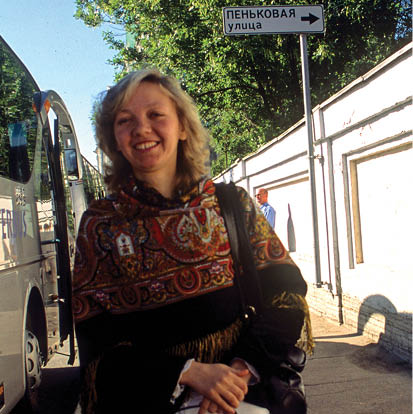
A tour guide in St. Petersburg.
1. Winter Palace – This palace is St. Petersburg’s premier attraction, which is the main building of an architectural ensemble that houses the world-renowned State Hermitage Museum. When the Italian architect Rastrelli designed the Winter Palace for Empress Elizabeth in the mid-18th century, he created a long, three-storey rectangular building with a central courtyard accessed from Palace Square. The majestic grandeur of this Russian baroque palace derives from its four facades, each slightly different but all embellished by a two-tier colonnade and an abundance of moulded decoration. During the reign of Catherine the Great, the palace complex was expanded to house her growing collection of Western art. She oversaw construction of the Small Hermitage, the Great Hermitage and the Hermitage Theatre. These buildings were interconnected by passageways with the Winter Palace.
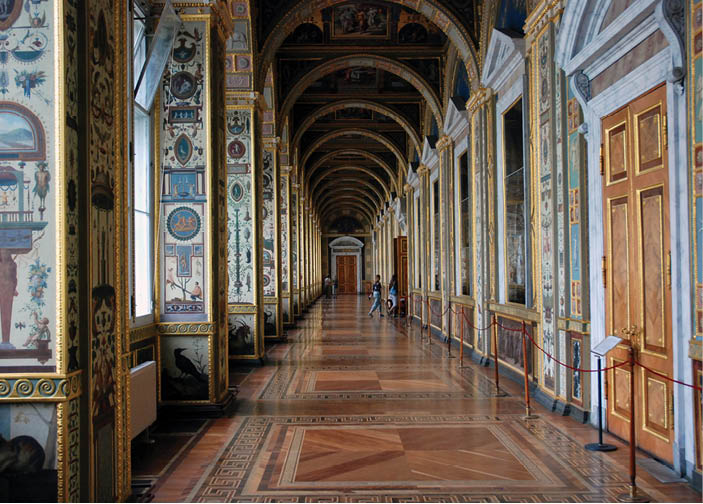
Interior view of the Hermitage.
The palace’s interior, which contains over a thousand rooms, was reconstructed in the neoclassical style following a fire in 1837. The Imperial Museum of the New Hermitage opened to the public in 1852. Since then, the museum’s original collection has expanded to include more than three million works of art and artifacts, including sculptures, drawings and more than 8,000 paintings of the Flemish, French, Dutch, Spanish and Italian schools, with works by Rembrandt, Rubens, Picasso and Matisse. The massive museum is divided into sections, including one featuring a tribute to Peter the Great, and another devoted to the life and literary works of Pushkin. The palace itself is a work of art, built on a monumental scale to symbolize the wealth and power of imperial Russia with its vaulted ceilings, grand staircases, granite columns and rooms richly adorned with gilt and marble. (Visit hermitagemuseum.org for a virtual tour of the palace and exhibit rooms.)
2. Palace Square – The Winter Palace overlooks Palace Square where the General Staff Building curves along the length of its southern boundary, creating an expansive public square. Constructed in the 1820s, this building is an excellent example of Russian Classicism, its two semi-circular wings connected by a triumphal arch crowned with a sculpture called Chariot of Glory. Originally housing government offices, gala rooms and the private apartments of the Russian chancellor, the building’s east wing became part of the Hermitage in 1993 to house new exhibitions of the museum.
Map of St. Petersburg

Standing in the middle of Palace Square is the Alexander Column, raised by Nicholas I to commemorate his brother Alexander I as victor over Napoleon in the Patriotic War of 1812. It took five years to raise this column, which rises 157 feet, making it the highest triumphal column in the world.
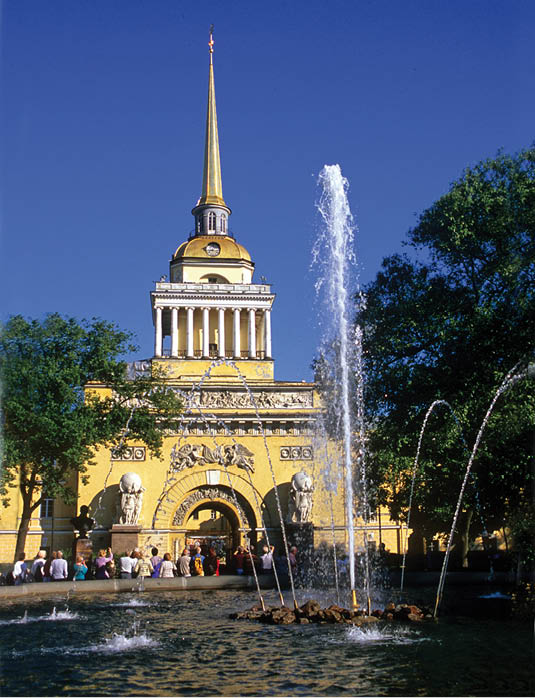
Admiralty Building.
3. Admiralty Building – Next door to the Hermitage is the golden-spired Admiralty Building, which originally housed the Admiralty Board and is now a naval college. Designed in the Empire style, it was built between 1806 and 1823. The writer Vladimir Nabokov, born in St. Petersburg in 1899, wrote a short story about this magnificent building entitled ‘The Admiralty Spire.’

The Bronze Horseman
4. Senate Square – This square (originally called Peter’s Square) is located beside the Admiralty Building is and is the site of an iconic equestrian statue of Peter the Great called The Bronze Horseman, the name given it in a famous poem by Pushkin. This statue, which has become a symbol of St. Petersburg (much like the Statue of Liberty is symbolic of New York City), was commissioned by German-born Catherine the Great to gain legitimacy in the eyes of the Russian people after seizing the throne in a palace coup. She chose a French sculptor named Falconet who shows the heroic figure of Peter mounted on his horse, which is rearing at the edge of a cliff while trampling a serpent beneath its hind hooves. The 20-foot-tall statue is mounted on an even higher pedestal of granite shaped from a massive stone slab that was found embedded in a marsh outside St. Petersburg. It took 400 men nine months to drag this massive slab of stone across four miles of countryside to the water’s edge where a specially constructed barge was used to transport it to Peter’s Square. During the siege of Leningrad (1941-44), the statue was protected from bombing and artillery fire with sandbags and a wooden shelter.
Peter’s Square was renamed Decembrists Square in 1925 to commemorate the Decembrist Revolt that took place here 100 years earlier. In 2008 its name was changed to Senate Square, in keeping with the neoclassical Senate and Synod buildings, designed by Carlo Rossi and now housing the Constitutional Court of Russia, which occupy the west side of the square. The Admiralty Embankment runs along the waterfront side of the square, affording wonderful views of the Neva and palaces across the river.
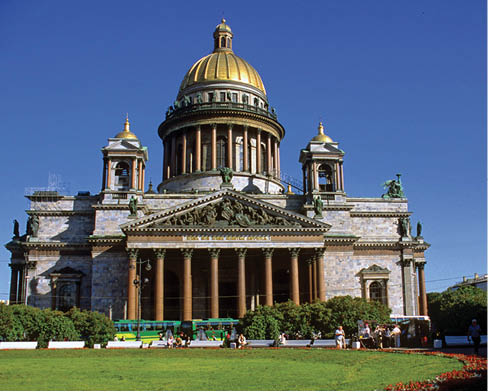
The exterior of St. Isaac’s Cathedral.
5. St. Isaac’s Cathedral – Next to Senate Square is this golden-domed cathedral, an imposing structure of granite and marble designed in the Classical style by a young French architect named Ricard de Montferrand. It became his life’s work, with construction begun in 1817 and the great gilded dome completed in 1842. Some 562 stairs lead up to the lantern atop this dome. The cathedral follows the Greek cross plan, its four façades graced with red granite columns standing 50 feet (16 m) tall. The light-filled interior is richly adorned with mosaics, paintings and gold-clad sculptures.
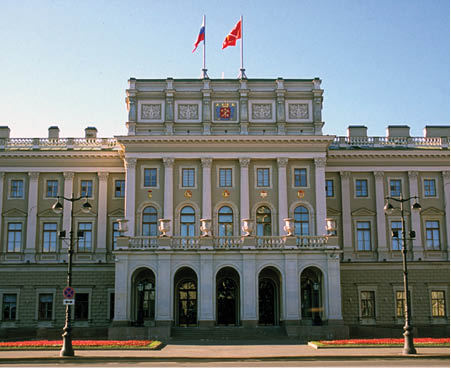
St. Petersburg’s City Hall.
6. St. Petersburg’s City Hall – On the south side of St. Isaac’s Square, facing the cathedral, is St. Petersburg’s City Hall. It occupies a neoclassical imperial palace (Mariinsky Palace) which was built from 1839 to 1844 for the daughter of Emperor Nicholas, Grand Duchess Maria Nikolayevna. An equestrian statue of Nicholas I stands in the centre of the square, and the luxury Hotel Astoria (which opened in 1912) is on the square’s east side, adjacent to the new Hotel Angleterre, built in the 1990s to replace the original (the Russian poet Sergei Yesenin hung himself in one of its rooms in 1925). Part of the square is actually an extremely wide bridge (the Blue Bridge) spanning a canal.
7. Mariinsky Theatre – A few blocks west of city hall is the Mariinsky Theatre, famous as the home of the Kirov Ballet. The modern Mariinsky II theatre opened next door to the original Mariinsky in 2013.

Wax mannequins portray Rasputin’s murder inside Yusupovskiy Palace.
8. Yusupovskiy Palace – The palace where the infamous Rasputin was murdered by a group of right-wing patriots, including a cousin of the czar, in December 1916. Rasputin’s scandalous hold over Empress Alexandra (who believed he possessed supernatural powers with which he kept healing her hemophiliac son) had undermined Emperor Nicholas II’s increasingly tenuous hold on power when Prince Yusopov invited the much-resented “healer” to his palace. Rasputin was served poisoned cakes and wine, but when he showed no ill effects, his panicked assassins shot him repeatedly and threw his body into the Neva River.

Kazan Cathderal.
Nevsky Prospekt, named after St. Petersburg’s patron saint Alexander Nevsky, is the city’s main avenue, which runs from the Admiralty through the central shopping and entertainment districts.
9. Cathedral of Our Lady of Kazan – Numerous churches also line this busy street, including the Empire-style Cathedral of Our Lady of Kazan, built in 1811. Field Marshal Kutuzov, a national hero who led the Russian army to victory over Napoleon in 1812, is interred here.
10. Grand Hotel Europe – Across the street at the corner of Nevsky Prospekt and Mikhailovskaja Street stands the five-star Grand Hotel Europe, whose guests have included Tchaikovsky and Elton John.
11. Gostiniy Dvor – A wide selection of stores is found on Nevsky Prospekt, most notably the elegant arcades of Gostiniy Dvor, the city’s largest department store.
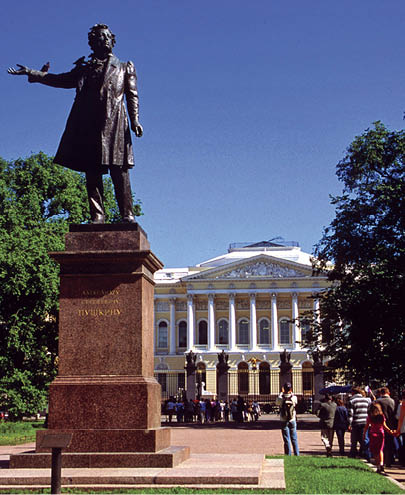
The monument to Pushkin outside the State Russian Museum.
12. State Russian Museum – Across the street lies the Passage – a shopping gallery covered with an arched glass-and-steel roof – which leads off Nevsky Prospekt toward Square of Arts and the State Russian Museum. Home to the world’s largest collection of Russian fine art, the museum is housed in Mikhailovsky Palace. Designed by Carlo Rossi and constructed between 1819 and 1825 for a son of Emperor Paul I, the palace is a masterpiece of Russian neoclassical architecture. Nicholas II acquired the palace for the state and transformed it into a museum, which opened to the public in March 1898. A monument to Pushkin, Russia’s national poet, stands in the middle of square, which is also the locale of the Stray Dog Cafe – an early 20th-century gathering place for writers and poets (including Boris Pasternak) who met here in the cellar of the Dashkov mansion.

The Church on Spilled Blood
13. Church of the Savior on Spilled Blood – Standing alongside the Griboedov Canal behind the Russian Museum is the much-photographed Church of the Savior on Spilled Blood. Officially called the Cathedral of the Resurrection of Christ, its 19th-century design is a revival of Russian medieval architecture. Richly ornamented and featuring an array of colourful onion domes that rival those of celebrated St. Basil’s Cathedral in Moscow, the church has an equally impressive interior of detailed mosaics covering all of the walls and ceilings. This spectacular church was dedicated solely to the memory of Czar Alexander II, who was assassinated at this site on March 13, 1881. He was riding in his carriage along the canal embankment when an anarchist threw a grenade which exploded and prompted the czar, who was shaken but unhurt, to get out of his carriage and remonstrate with his presumed attacker. This is when another conspirator exploded a second hand bomb and mortally wounded the czar. Bleeding heavily, he was taken to the Winter Palace where he died a few hours later. A shrine was erected on the exact spot of the attack, which was later enclosed within the walls of the church built by Alexander III as a memorial to his father. Work began in 1883 but was not completed until 1907, during the reign of Russia’s last czar, Nicholas II. Ransacked and looted following the Russian Revolution, the church became a temporary morgue during the Siege of Leningrad, then a warehouse for vegetables after the Second World War. Never a public place of worship, the restored church reopened as a museum in 1997 and is now one of St. Petersburg’s major tourist attractions.
14. Saint Michael’s Castle – Also called Mikhailovsky Castle or Engineers Castle, this castle is where another royal assassination took place.Today it’s a branch of the State Russian Museum, housing official portraits of Russian emperors and empresses. Completed in 1801 as a royal residence for Paul I, who feared an assassination plot, the castle was surrounded on all sides by canals and moats, its bridges guarded by sentries. Within weeks of moving into his new home, however, the unpopular czar was murdered in his bedroom by some noblemen who resented his autocratic policies. The palace subsequently became an engineering college attended by such illustrious Russians as Dostoyevsky.

Peter the Great’s Summer Palace
15. Summer Palace of Peter the Great – The Summer Garden is part of the State Russian Museum and contains the Summer Palace of Peter the Great – a modest stone structure he had built in 1710 in which to spend his summers. Situated on a point of land where the Fontanka flows into the Neva, water would wash against the sides of the house and arriving boats would tie up alongside to mooring rings mounted on the facade. The palace’s wooden floor beams were reminiscent of ship construction, and oak – a wood traditionally reserved for Russian shipbuilding – was used for the palace doors, stairs and wall panels.
16. Marble Palace – Lying to the west of the Summer Garden is the Field of Mars (a military parade ground) and the adjacent Marble Palace. Built in the late 1700s for Count Grigory Orlov (a favourite of Catherine the Great), the Marble Palace is an outstanding example of early neoclassicism in Russia, its facades and interior decorated with marble of various colours. The palace housed the Lenin Museum from 1937 to 1991, at which time it became a branch of the State Russian Museum housing permanent art collections.
17. Log Cabin – Peter the Great’s original residence – a log cabin – is situated directly across the Neva from the Summer Gardens. Built in three days by Swedish carpenters, this pine log cabin is where Peter first lived while planning his new city. The cabin’s interior doors came from captured Swedish ships and the walls were covered with sailcloth. Peter would cross the Neva in a light boat he built himself. The cabin is now a museum, perfectly preserved and protected from the elements by a red-brick pavilion.

The battleship Aurora
18. Aurora – This historic battleship is docked a few hundred yards upstream from the Peter the Great’s cabin and has been turned into a museum. At 2:00 a.m. on October 25, 1917, this ship gave the signal (by firing a blank shot) to storm the Winter Palace and seize power from the provisional government.

Peter and Paul Fortress
19. Peter and Paul Fortress – On Zayachy Island, a short distance downstream from Peter the Great’s log cabin, is the Peter and Paul Fortress. Built to defend St. Petersburg from Swedish attacks, it is the city’s oldest structure and within its walls is the city’s first stone church – the Cathedral of St. Peter and St. Paul. Designed by Trezzini in the early baroque style, the church’s gilded spire is 404 feet high and crowned with a golden angel holding a cross. The cathedral’s royal crypt contains the tombs of Peter the Great and most of his successors, including Nicholas II, who was reinterred here in 1998.

Remains of Russia’s last czar and his family in the Cathedral of St. Peter and St. Paul.
The remains of this last czar, his wife and three daughters were found buried in a forest near Yekaterinburg in 1991, and the remains of his son and other daughter were found nearby in 2007. (Nicholas and his family were canonized by the Russian Orthodox Church in 2000, and formally rehabilitated by Russia’s Supreme Court in 2008 with a ruling that their killings were premeditated murder.) The fortress also contained a high-security political jail where past prisoners included Dostoyevsky, Trotsky and Lenin’s brother Alexander. Parts of the former jail are now open to the public.

The Rostral Columns
20. Rostral Columns – Across the river from the fortress, standing on the Spit of Vasilyevsky Island, are the eye-catching Rostral Columns – constructed as oil-fired navigation beacons in the 1800s and studded with ship’s prows.
21. Naval Museum – They flank the Stock Exchange, a white colonnaded building completed in 1810 which now houses the Naval Museum. Nearby are the side-by-side, red-and-white buildings of St. Petersburg State University, constructed in the early 1700s to house government ministries and given to the university in 1835. Famous scholars and important figures of Russian culture and politics have studied at this prominent university, including Lenin who passed his law finals in 1891.
22. Menshikov Palace – Other buildings of note along University Embankment include the stately Menshikov Palace – built for Peter the Great’s chief lieutenant Alexander Menshikov, who effectively ruled Russia for several years following the czar’s death until his enemies forced him into exile. The restored palace is now a branch of the Hermitage, housing a collection of Russian cultural artifacts from the early 1700s.
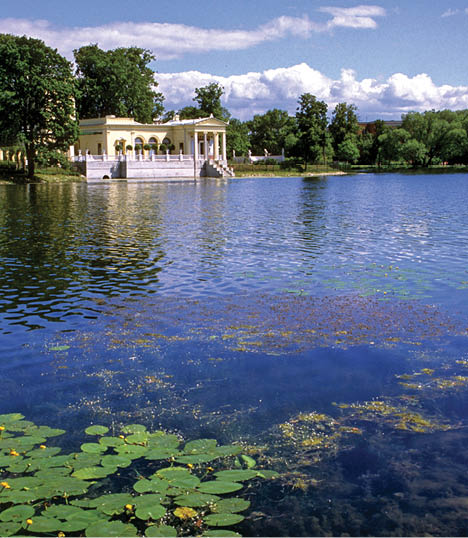
A czarina’s summer pavilion at Olga’s Pond in Peterhof.
23. Alexander Nevsky Monastery – Nevsky Prospekt, the city’s main avenue, eventually leads out of the downtown core to the Alexander Nevsky Monastery, founded in 1710. Its extensive grounds contain two baroque churches, one neoclassical cathedral and two cemeteries. The graves of Dostoyevsky, Tchaikovsky, Rimsky-Korsakov, Mussorgsky and Glinka are at the Tikhvin Cemetery.
24. Smolny Cathedral – Intended as the centrepiece of a monastery being built to house Peter the Great’s daughter Elizabeth, who had chosen to become a nun until a bloodless palace coup (led by her and the imperial guards) placed her on the throne in 1741. The cathedral was designed by Rastrelli, who also designed the Winter Palace, and this blue-and-white edifice is crowned with golden domes. The nearby Smolny Institute was constructed in the early 19th century as a school for girls of the nobility. It became Lenin’s Bolshevik headquarters during the October Revolution in 1917. Sergei Kirov, one of Stalin’s most trusted aides, was assassinated here in 1934, probably at Stalin’s order. City administration has operated here since 1991, and Putin served at this office as deputy mayor before becoming prime minister (and then president) of Russia.
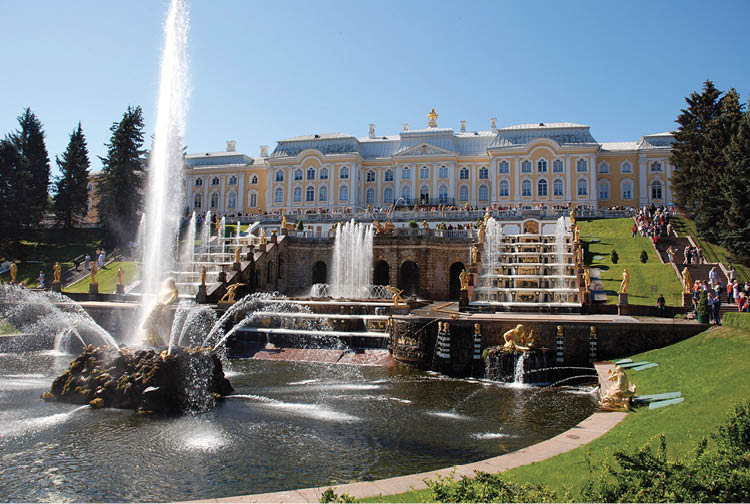
The Grand Palace at Peterhof.
The wealth and opulence of the Romanov dynasty spread outward from St. Petersburg to the numerous summer palaces and pavilions they built for themselves throughout the 18th and 19th centuries. These royal residences were occupied and destroyed by German troops during the Siege of Leningrad, but most have since been rebuilt and are today major tourist attractions.
The royal estate of Peterhof (20 miles west of the city) is often called the Russian Versailles for its ornate palaces, landscaped gardens and dazzling array of fountains and statues. The Grand Palace stands on a bluff, its terrace overlooking the magnificent Grand Cascade – a resplendent ensemble of 64 fountains, with water cascading in broad sheets past glittering gilt statues. The main fountain’s centrepiece statue of Samson wrestling the jaws of a lion symbolizes Russia’s defeat of Sweden in the Great Northern War. A natural spring in the Upper Garden behind the Grand Palace supplies the gravity-fed water system that operates the fountains.

Peterhof’s Grand Cascade.
The Lower Park contains an extensive array of individual fountains as well as Peter the Great’s original seaside palace, called Monplaisir, which resembles a Dutch colonial mansion. He also built Marly Palace, inspired by Louise XIV’s royal hunting lodge. Subsequent czars added to Peterhof’s palatial grounds, with Empress Elizabeth hiring Rastrelli (the architect of the Winter Palace) to remodel the Grand Palace, and Nicholas I building Cottage Palace (a gothic mansion) in adjacent Alexandria Park.
Nicholas I also commissioned summer pavilions for his wife Alexandra and youngest daughter Olga, which are located on the edge of Olga’s Pond opposite Peterhof’s Upper Garden. The adjacent town of Peterhof was renamed Petrodvorets in 1944 but reverted to Peterhof (German for ‘Peter’s home’) in the early 1990s.

The ballroom in the Grand Palace.
The town of Pushkin, named in Soviet times to honour Russia’s national poet, was originally called Tsarskoye Selo (Czar’s Village) when founded by Peter the Great in 1708. The original Catherine Palace, built for Peter’s wife, was later demolished and replaced with a palace of unsurpassed grandeur by their daughter Empress Elizabeth, who commissioned Rastrelli to create a palatial residence in keeping with her extravagant tastes. The palace’s blue-and-white rococo façade is ornamented with gilded statues and its interior is famous for the Amber Room – an entire chamber lined with panels of amber, gold leaf and mirrors. Destroyed by German forces during World War II, this room was recreated by craftsmen who worked on this painstaking project from 1982 until its completion in 2003. Nearby is Alexander Palace, home of the last Romanov czar, Nicholas II. Pushkin’s vast royal park is filled with grottoes, canals and lakes.
A few miles from Pushkin is Pavlovsk, named in honour of Paul I, who was given this royal estate by his mother Catherine the Great. The neo-classical palace is less ostentatious than Pushkin or Peterhof but is admired for its elegant design and English-style landscape garden.
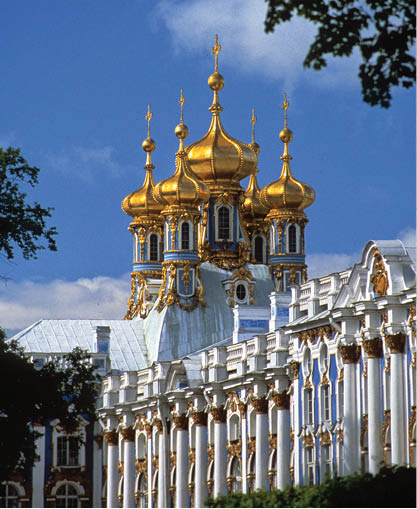
Catherine Palace in Pushkin.
Yet another imperial palace is at Gatchina, where Catherine the Great bought the local village and surrounding lands to build a palace and park for her favourite supporter, Count Grigory Orlov (one of the conspirators who placed Catherine on the throne by murdering her husband Peter III). Orlov had fallen out of favour by the time the palace was completed in 1781, and Catherine’s son Paul was given the palace. Despite the estate’s association with one of his father’s assassins, Paul liked the palace’s fortress-like appearance which he enhanced with cannons, sentry boxes and a moat.

Count Leo Tolstoy.
St. Petersburg in the 19th century was a brilliant cultural centre, producing towering figures of the arts. Alexander Pushkin – the ‘Russian Shakespeare’ – was a young nobleman when exiled to the Crimea in 1820 but pardoned by the czar six years later. Pushkin’s major works include his masterpiece Eugene Onegin and his famous poem The Bronze Horseman, inspired by the bronze equestrian statue standing in Senate Square. Pushkin was killed in a duel at the age of 38.
The times in which Pushkin lived among St. Petersburg society are captured in Leo Tolstoy’s novels Anna Karenina and War and Peace, the latter vividly describing Napoleon’s disastrous military invasion of Russia in 1812. Tolstoy, born in 1828, was a member of the Russian nobility and wrote firsthand about sumptuous balls and all-male dinner parties where copious amounts of liquor were consumed. Tolstoy wrote about what he knew, having enjoyed a profligate life in St. Petersburg before serving in the Russian army, followed by marriage and children. In his later years he adopted a doctrine of Christian love and non-violence, rejecting organized religion and personal possessions.

The Mariinsky Theatre, home to the Kirov.
Tolstoy was a family friend of Boris Pasternak, who became a hero of Russian intellectuals during the Stalinist era. Pasternak’s masterpiece is the novel Dr. Zhivago, for which he won the 1958 Nobel Prize in Literature. Pasternak was greatly influenced by Tolstoy, who is widely regarded as one of the world’s greatest novelists, along with his contemporary Fyodor Dostoyevsky.
The son of an army surgeon, Dostoyevsky didn’t enjoy the privileged lifestyle of Count Tolstoy. His father was a violent alcoholic who was brutally murdered by his own serfs when Dostoyevsky was 18. Shortly after graduating from military engineering school in St. Petersburg, Dostoyevsky was arrested for belonging to an illegal group of radical utopians and was sentenced to death, only to learn at the end of a pre-execution ceremony that he had been granted a reprieve. Sent to a Siberian penal colony for four years of hard labour, he endured great physical and mental pain, including repeated attacks of epilepsy, before returning to St. Petersburg. Dostoyevsky’s powerful prose and psychological insights are showcased in such masterpieces as Crime and Punishment and The Brothers Karamazov.
The Russian temperament is also reflected in its legacy of classical music, which thrived in the latter half of the 19th century with a string of famous composers studying at the St. Petersburg Conservatory. These included Tchaikovsky, Moussorgsky (a former officer of the Imperial Guard) and Rimsky-Korsakov, who gave up a naval career to compose orchestral works. Rimsky-Korsakov’s pupils included Prokofiev and Stravinsky, while Tchaikovsky strongly influenced his friend Rachmaninoff.
The St. Petersburg Ballet, known to the world as the Kirov, was founded in the 1700s as the Imperial Russian Ballet. In 1889 the company moved into the Mariinsky Theatre where it premiered Tchaikovsky’s Sleeping Beauty and Swan Lake. During the Soviet era, the company’s name was changed to honour the Bolshevik revolutionary Sergey Kirov and the name is still used when touring abroad. Famous dancers at the Kirov have included Rudolph Nureyev and Mikhail Baryshnikov. George Balanchine (born as Georgi Balanchivadz) studied dance and music in St. Petersburg.

